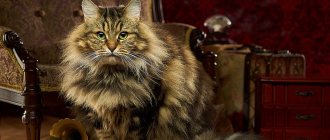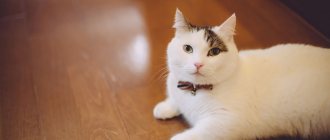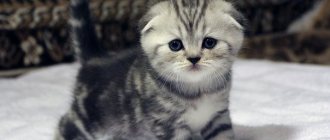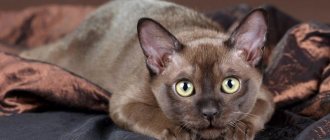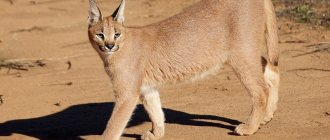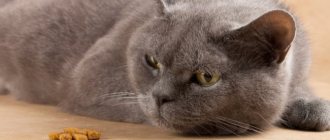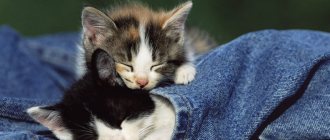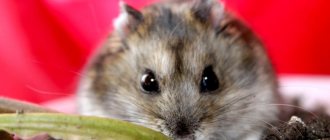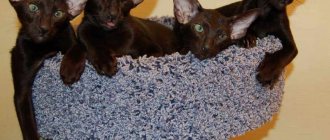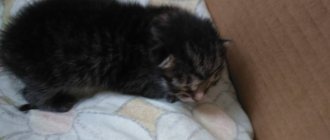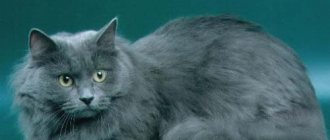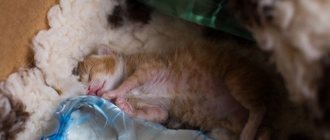History of the Norwegian Forest Cat breed
Norwegian Forest Cat
As you can guess from the name (in different dialects of the Norwegian language, “forest” sounds differently, so there are two options in use - Norsk skogkatt or Norsk skaukatt), these fluffy beauties come from the Scandinavian forests. Scientists today do not have accurate data on how long they live next to humans. The hypothesis is very popular that the countdown dates back to the 16th century, when Angora cats arrived in Western Europe from Ankara. The harsh climate of the peninsula and the need to climb trees a lot led to the appearance of undercoat, strengthening of the claws and the formation of an athletic physique.
However, we cannot completely discount the possibility that, under the influence of external factors in the new environment, the Angora mutation responsible for the length of the coat occurred and became established in Felis silvestris grampia, regardless of its Mediterranean relatives. And those same wild Scottish cats were brought to the territory of modern Norway by the Vikings, who colonized the Shetland, Orkney and Hebrides islands back in the 9th-10th centuries. This version is supported by the traditional image of the leader of the Valkyries, the goddess of fertility, love and war, Freya - the ancient sagas depict her in a chariot drawn by two cats, whose bushy tails are clearly reminiscent of our today's heroes.
In the 19th and first half of the 20th centuries, many Norwegian and Swedish families kept these cats as pets. In the 1930s, after their triumphant appearance at an international exhibition in Germany, serious work began on the phenotype of the breed, the goal of which was to preserve the best natural qualities and weed out undesirable traits. But with the outbreak of World War II, this had to be forgotten, and in the second half of the 40s, the very existence of the Norwegians was threatened due to spontaneous crossing with other cats. The situation was brought under control only by the efforts of enthusiasts. A special committee was created that gave permission for breeding only to those owners whose animals met the standard. The efforts of the Norwegian Association of Pedigree Cat Fanciers were rewarded: King Olav V recognized Skogkatts as the official breed of the country, and in 1977 Pans Truls received the coveted registration with the International Cat Federation (FIFe). By the way, it was he, together with Pippa Skogpuss, who is considered the founder of the modern breed. Born from their union, Pans Silver became the father of 12 litters at once and today is mentioned in almost every pedigree of a purebred Norwegian.
World recognition gave breeders the right to draw up international pedigrees. At the same time, the export of Norwegian forest cats abroad began. Now most of these pets live in Sweden, but other European countries are not far behind. In the USA, local Maine Coons (which, by the way, some are inclined to consider as descendants of the Norwegians) are too serious competition for guests from overseas to speak of real popularity. In Russia, among large breeds, Siberians are still numerically superior, although specialized nurseries have already been opened in Moscow, St. Petersburg, Novosibirsk, Vladivostok and some other cities.
Habitat
The Amur cat settled along the shores of the Sea of Japan and near the Amur basin. In addition to Russia, the Far Eastern cat is common in China, Japan and the Korean Peninsula, inhabiting the entire space from Hindustan to the Malay Archipelago.
Amur cat in Primorsky Krai
Since the area inhabited by the Amur cat is large and climatically heterogeneous, the habits of wild cats from different regions may differ from each other. In particular, the habitat affects the breeding periods and the mass of cats.
Amur cats are happy to explore the steppe
The tropical orientation of the Far Eastern cat suggests that impenetrable forests are not the best place for animals like him. However, circumstances were such that the Amur cat emigrated to the snowy Ussuri region and remained to live there forever.
Appearance of the Norwegian Forest Cat
Norwegian Forest Kitten
The size of the Norwegian Forest Cat ranges from medium to large. Like other large breeds, they reach final maturity quite late - at 4-5 years. Animals appear more massive due to their thick fur. The exact height and weight indicators are not indicated by the WCF breed standards, but experienced breeders say that the norm for an adult is a height of 30-40 cm, weight depends significantly on gender: cats weigh on average 5.5 kg (although graceful 4-kg cats are often found ladies), and males reach 6-9 kg.
Head
In the shape of an equilateral triangle, the outlines are smooth, the profile is straight, without a “stop”, the forehead is high and almost flat. The cheekbones are not pronounced, geometrically straight and long. The nose is of medium length, almost always pink. The jaws are powerful. The chin has a square or round outline.
Eyes
The eyes of the Norwegian Forest Cat are large and expressive. They have an oval or almond shape. Placed a little askew. The preferred color is green, gold and shades thereof, although other options are not considered a disadvantage. In white cats, heterochromia (eyes of different colors) is allowed.
Ears
Medium in size, with a wide base and slightly rounded tips on which “tassels” are desirable. Set high and wide on the head, the outer edge continues the line of the head. The inside is covered with long hair.
Neck
Medium length, flexible, well developed muscles.
The muzzle of a Norwegian forest cat
Body
Red Norwegian Forest Cat
The body of the Norwegian forest cat is large, powerful, and relatively long. The bones are strong, heavy, the muscles are dense and well developed. The chest is round and wide. The back of the body is above the shoulder line.
Limbs
The front ones are of medium length and powerful. The hindquarters are significantly longer, athletic, the thighs are strong and muscular.
Paws
Round or oval, wide. The toes are well developed, with thick tufts of hair located between them.
Tail
Flexible and long - when bent, it reaches the line of the shoulders or neck. Placed high. Wide at the base, somewhat tapering towards the tip, always fluffy.
Wool
Semi-long, thick, with a fluffy and moderately wavy undercoat. The outer hair is smooth and has a water-repellent effect due to its oiliness. Because of this feature, the Norwegian Forest Cat's coat can look a little unkempt. The length depends on the location: the shortest hairs on the shoulders and back gradually lengthen, turning into a spectacular “collar”, “bib” and “pants”. The degree of expression of such decorating fragments may vary and is not strictly regulated by the rules.
Color
Norwegian forest cat tortoiseshell color
Can be solid, bicolor, shaded, smoky, tabby. In general, 64 color variants of Norwegian forest cats are recognized, but the list depends on the specific organization. Thus, the International Federation does not allow light brown, yellowish-brown and shades that are characteristic of Burmese cats, but considers white in any variations to be the norm. And the French Central Society of Cat Fanciers (SCFF) outlaws chocolate, lilac Stogcatts and color-point cats.
Flaws
Sizes too small. Insufficiently strong bones. Poorly developed muscles. Square body. The head is square or round. A profile with a “stop”, that is, a transition from the forehead to the rest of the muzzle with a pronounced depression. Small or round eyes. Small ears. Short legs. Short tail.
Disqualifying Faults
The coat has a silky texture, is dry or matted. Amputated claws, deafness, location of the testicles outside the scrotum.
Accommodation during freezing temperatures
When severe frost sets in, it begins to descend to human habitats to hunt rodents in dilapidated buildings. When it senses danger, it hides in the treetops. Finds refuge in large tree hollows and among rock crevices overgrown with bushes. Does not disdain old badger and fox holes. For convenience, leaves and dry grass are placed in the hollow. It climbs trees and rocks very well and can swim. The Amur forest cat arranges several secluded places on its territory, where it systematically enters. In winter, it hides in one of the most convenient lairs.
Photos of Norwegian Forest Cats
Personality of Norwegian Forest Cats
Norwegian forest cat with a person
Speaking about the inner world of Stogkatts, first of all, it is worth noting that by their temperament they are typical children of Scandinavia. Balanced, outwardly they rarely show emotions, prefer not to get involved in conflicts, treat others kindly, but do not tolerate violations of the boundaries of personal space - in a word, the character is Nordic.
Since Norwegian Forest Cats have long been left solely to the care of nature, they have a fairly strong desire for a “wild” life. Of course, Norwegians can be kept in a city apartment, but they will feel most comfortable in a private home, where they have the opportunity to go for walks every day and hone their hunting skills. In this case, do not be alarmed if your pet disappears from sight for several hours or even a whole day - periods of independence and “roaming” are completely normal for representatives of this breed. But at other times, you may well receive a severe reprimand for a long absence, because Norwegian forest cats really don’t like being alone when the soul requires company. A particularly acute reaction is caused by the absence of the “main person” - that family member whom everyone’s favorite person distinguishes with his deep affection and with whom he spends his evening rest more willingly than with others.
In general, Norwegian forest cats are very friendly and are perfect for living in a large family with small children and other animals. In response to obsessive attention from children or dogs, you will not see aggression; Norwegians prefer to retreat and wait out the unpleasant situation in a secluded place.
Norwegian Forest kitten with dog
If you want to teach your cat funny tricks and basic commands, choose anyone other than Norwegian cats. Understanding perfectly well what they want to achieve from them with words and treats, these wayward northerners simply ignore the trainer. They make their own decisions and refuse to obey the whims of others.
High intelligence goes hand in hand with curiosity and excellent memory. Skogkatts like to monitor the movements and habits of household members; they know exactly what order of things is typical in their home, and immediately draw the owner’s attention to any deviations from the norm, be it water dripping from somewhere or a bag of groceries left for a long time in the middle of the room. Norwegian forest cats have a quiet voice compared to other relatives, and they do not use “sound notifications” too often, so they will not bother their neighbors with their concerts in vain.
Breeders note the playful disposition of this breed, and it is not strictly tied to age. Even older cats (if their health allows them) with great pleasure and enthusiasm of a small kitten hunt for toy mice, balls and the mark of a laser pointer.
Population status
Currently, the Amur forest cat is included in the Red Book. The exact number of cats of this subspecies is unknown today. According to rough estimates, it does not exceed two and a half to three thousand individuals.
According to the generally accepted point of view, the number of Amur cats has decreased by at least a third. Part of the responsibility for the sharp decline in wild cats lies with humans themselves, as they are involved in:
- plowing virgin soil;
- cutting down bushes;
- setting fire to stakes (small forests in the fields).
Many representatives of the subspecies fell into hunting traps and snares, originally intended for hares. Uncontrolled natural fires also played a destructive role.
By the way! During the Soviet era, the forest cat was considered an enemy of man, along with the wolf and lynx. For the capture and killing of wild cats, the village council provided a reward, which led to an increase in those wishing to exterminate the harmless cat.
All the negative factors described above led to the fact that in 2015 there were only a few thousand Amur forest cats.
Prevention of extermination
Thanks to the efforts of animal rights activists, a significant fine was introduced for the destruction of Amur cats, reaching several thousand rubles. In the near future, it is planned to systematically inform local residents, especially hunters, about rare representatives of the local fauna, as well as about the usefulness of wild cats in the fight against rodents. Also, Far Eastern cats are under vigilant supervision in Japan, where about fifty representatives of the subspecies live.
Reserves
It is difficult to overestimate the contribution of protected areas in the regions, which provide greater safety for animals. The list of such territories includes
- Land of the Leopard National Park;
- Kedrovaya Pad Nature Reserve;
- Bolshekhehtsirsky Nature Reserve;
- Lazovsky Reserve;
- Khanka Nature Reserve;
- Ussuri Nature Reserve.
Zoos
The Far Eastern leopard cat is a rare guest in zoos. It is mainly kept in zoos in China and Japan, but in Russia there are several places where this animal lives, for example, the Barnaul Zoo.
They say that Amur cats do not live in zoos, but simply die for a long time
There are several reasons for such a low prevalence of the Amur cat. Firstly, catching a wild cat specifically for collection is not an easy task. That is why the Amur cat was and remains one of the most poorly studied subspecies.
Secondly, leopard cats languish in captivity. Even in a zoo, where no one and nothing threatens the cat, the wild animal remains wild and extremely cautious. As a rule, he builds a hole for himself or uses an already prepared one, only occasionally coming into contact with people and other inhabitants.
When surrounded by people and other animals, cats remain withdrawn and cautious.
Despite the unadaptability of wild cats to life in a cage, in zoos and enclosures the life expectancy of representatives of the subspecies is 17-18 years, while in the wild they are given 10-12 years. However, there are a variety of assumptions about the number of years allotted to a forest cat by nature. Some argue that 18 years is not the limit.
Care and maintenance
Handsome!
As already mentioned, the ideal home for a Norwegian forest cat would be a private home with its own yard. This way you can guarantee sufficient physical activity, in addition, it is the fresh air that promotes a healthy shine to the coat. If you only have an apartment at your disposal, it is strongly recommended that you take your pet for a walk at least once a month, remembering to wear a harness of the appropriate size to prevent attempts to go on an independent journey or climb to the very top of a spreading maple tree. By the way, the ability to climb vertical surfaces is very important for Norwegians, as it is part of their natural behavior. As a result of constant training of many generations of ancestors, the claws on all four paws became so powerful that this cat (the only one among the domesticated ones, by the way!) is able to climb down a sheer trunk upside down without any problems. When keeping an apartment, you should definitely purchase a special cat tree with a large platform on top, from where she can watch what is happening in the room.
Experts do not put forward specific requirements for the daily diet of the Norwegian forest cat. The only point that deserves special attention is the serving size. Since Norwegians are larger than many other breeds, they require slightly more food. When calculating, it is necessary to take into account the current weight of the pet. Otherwise, the advice is standard: professional premium food or a balanced natural diet, which includes animal proteins, grains and vegetables. It is important not to overfeed an animal at any age, since obesity provokes many serious diseases. It is imperative to ensure constant access to fresh water, especially if you have opted for dry food.
I ate my fill
Looking at the luxurious fur coat of the Norwegian Forest Cat, many are sure that with the advent of such a pet, all their free time will have to be devoted to caring for the fur. In fact, the situation is completely different. Nature has made sure that thick and long fur does not cause serious trouble for the animal, because in the northern forests one can hardly count on regular visits to grooming salons. The special structure of the undercoat and guard hairs prevents matting, so there are no problems with the formation of tangles (as, for example, in Angora and Persian cats). Of course, in spring and autumn, during the period of active molting, it is recommended to thoroughly comb the animal every two days, or even daily. This way you will avoid the formation of an additional “carpet” of fallen hair on all surfaces in the house. The rest of the time, it is enough to take up a special comb once a week.
Washbasins
The water-repellent fat layer on the coat plays an important role in maintaining the health of Norwegians, so bathing them should only be done as a last resort:
- if flea treatment is necessary;
- if the cat got really dirty during a walk;
- before participating in the exhibition.
It is worth considering that the washing process, due to the nature of wool, requires time and patience. The liquid simply drains from the guard hairs, leaving the undercoat dry, so experienced breeders advise first rubbing a special shampoo for oily wool dry, and only then turning on the water. It is likely that you will need more than one soaping, but conditioner will definitely be superfluous. If the room temperature does not threaten the Norwegian Forest Cat with hypothermia, it is better to simply dry it with a towel and wait until the fur coat dries itself.
Animals that do not have free access to the outside world should have their nails trimmed every two to three weeks. The ears are cared for at the same frequency using cotton swabs and special products.
Norwegians love boxes too...
And packages
Number
It may seem strange, but there is no exact data on the number of forest Amur cats. They are so secretive that it is not possible to make even an approximate count. However, they are currently listed in the Red Book as an endangered species.
The reason for this was not hunting, as it might seem, but the loss of places suitable for habitation. Every year there are fewer and fewer isolated forests or lowlands not plowed for fields. The annual “burnings” - burning of last year’s leaves and fallen branches - also pose a huge danger to forest inhabitants.
Fortunately for the Far Eastern cat, it cannot boast of particularly valuable fur, and in Russia it was never hunted as a fur-bearing animal. But in China, the “Money” predator was killed for a long time precisely for the sake of fur. Now hunting for it is prohibited, and it is included in the list of animals protected by law.
Health and disease of the Norwegian forest cat
Natural selection, which determined the development of the breed for several centuries, led to the formation of a strong and healthy population. Of course, recent human intervention - selective breeding, a limited number of genetic lines - has had negative consequences, but in general, Norwegian forest cats remain strong and hardy. They are at risk of only a few serious diseases:
- restrictive cardiomyopathy – decreased compliance of the heart muscle and subsequent development of chronic heart failure;
- diabetes – dysfunction of the endocrine system due to insulin deficiency;
- hip arthrosis is a chronic joint disease;
- retinal dysplasia - abnormal formation of retinal layers during intrauterine development;
- chronic renal failure – decreased kidney function;
- glycogenosis type IV - a genetic disease that provokes liver metabolic disorders and cirrhosis, such kittens are born dead or die soon after birth, in rare cases they live up to 4-5 months;
- Purivate kinase deficiency is another genetic disease that causes a reduction in the number of red blood cells and anemia.
The last two are becoming less common today, since genetic analysis makes it possible to identify carriers of recessive genes and exclude the possibility of having a litter from two carriers.
At the age of 6-8 weeks, the first injection of a polyvalent vaccine is carried out (most often this is the concern of the breeder, not yours), repeated vaccination is carried out at 6-8 months. Next, it is enough to do the vaccinations recommended by your veterinarian annually.
With due attention to the health of the cat on the part of the owners, proper nutrition, sufficient physical activity and the absence of congenital diseases, Norwegian forest cats live 15-16 years, maintaining activity and a tenacious mind.
Norwegian Forest Cat in its element
Can he live at home?
Many people tried to tame the Far Eastern cat, but there were no successful attempts. It is uncomfortable for a predator to live at home; he treats owners with caution. Even if the animal was taken immediately after birth, as an adult it tends to leave its home and return to the forest. Despite this, cats are still being studied. For these purposes, they resort to a special cage in which the meat is placed. When an animal enters it to take a piece, it is caught, euthanized, and put on a collar equipped with a beacon. In this way, we obtained data on the habits and lifestyle of Far Eastern cats.
How to choose a kitten
Like any other purebred cat, the Norwegian Forest should only be purchased from reputable catteries or from trusted breeders. An attempt to save money and buy a pet at the “bird market” or through private advertisements most often ends with you getting an ordinary fluffy “nobleman” or, even worse, a baby with a lot of genetic abnormalities. If you plan to participate in exhibitions, you should carefully check the pedigree of the parents and the compliance of the kitten with the approved breed standard, because minor flaws from the point of view of an amateur can lead to low expert ratings and even disqualification. It is extremely difficult to assess the quality of wool at a young age, so here they focus on the external data of the parents.
The general requirements for a kitten of any class are simple:
- mobility, playfulness and curiosity, which indicate normal development and health;
- a good appetite;
- clean eyes and ears without foreign secretions;
- pink gums;
- absence of skin parasites;
- slightly rapid, but even breathing after physical activity (the opposite indicates problems with the cardiovascular system).
Important indicators are also the living conditions of the mother and kittens - sufficient space for active play, cleanliness, availability of toys, regime and quality of food. Be sure to ensure that the first required vaccination has been completed.
What threatens the Far Eastern predator?
The Amur forest cat is considered a rare animal, the number of which is not known specifically. The most serious reason affecting the population decline is considered to be human economic activity and, as a consequence, a decrease in the protective properties of biotopes
In addition, the presence of stray dogs and systematic burning of vegetation are also important. The Far Eastern Amur cat has difficulty adapting to changes in natural landscapes caused by human activity
This is very sad, because the Amur cat, photos of which cannot even convey all the beauty and charm of this predator, is a unique animal. By the way, the Bank of Russia depicted the Amur forest cat on a silver coin issued in the “Red Book” series in 2004.
Photos of Norwegian Forest Kittens
How much does a Norwegian Forest cat cost?
The price of a Norwegian Forest cat kitten varies widely.
This is not about the difference between a baby with a pedigree and one bought “from hand” - this issue is clarified above. The fact is that all purebred animals are divided into conventional classes. The most affordable option is the so-called “domestic” Norwegian, that is, a kitten whose exterior has more or less serious deviations from the breed standard. If you are looking for a friendly pet for the whole family, the length of its tail, the smoothness of its profile or the set of its ears are not decisive, are they? But the acquisition will not be a blow to the family budget: depending on the prestige of the nursery and the eminence of the ancestors, the price of such a fluffy starts from 10 thousand rubles.
For a future exhibition participant, breeders ask 30-40 thousand rubles and more, here the figure additionally depends even on the color and eye color. Only kittens born from a mother who is registered in the cat lovers club have permission to participate in competitions and breed. There, one-and-a-half-month-old babies undergo certification and receive an official metric. Without the latter, you will later (at the age of 6-7 months) not be able to obtain an international pedigree. The cost of Norwegian forest kittens from elite parents in the best nurseries can reach 100 thousand rubles.
Is it possible to buy an Amur cat?
It is important not to confuse the Far Eastern (Amur) leopard cat with the Bengal, information about which you can find on the websites of people involved in crossing different types of wild cats for the purpose of profit. These “breeders” will tell you about the delights of such pets, but you shouldn’t believe them
There are also people who sell taiga cats.
But even if you really like the Amur cat, buying one secondhand is a bad idea. But the main thing is not even the price (the Amur cat and the leopard cat are expensive, but they cost even more), but something else. We think that any sane person understands that the place of wild cats is in their natural habitat, and from humans they only need a place in the sun, peace and a clean environment.
